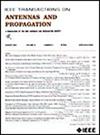稀疏平面阵列合成的三步映射法
IF 4.6
1区 计算机科学
Q1 ENGINEERING, ELECTRICAL & ELECTRONIC
引用次数: 0
摘要
本文提出了一种利用三步映射(TSM)方法合成稀疏平面阵列的有效方法。该方法将阵列优化过程分解为区域划分、x方向布局和y方向布局三个独立步骤,有效地解决了阵列孔径、元素数量、相邻元素最小间距等多种约束条件下的稀疏平面阵列设计难题,同时避免了不可行解。与现有的矩阵映射方法相比,该方法消除了在给定行或列中排列元素的最大数量的限制,并且能够在元素定位中提供更大的自由度(DOFs)。数值仿真结果表明了该方法的有效性和可靠性,优于现有的矩阵映射方法。本文章由计算机程序翻译,如有差异,请以英文原文为准。
A Three-Step Mapping Method for the Synthesis of Sparse Planar Arrays
This article proposes an effective approach for synthesizing sparse planar arrays using the three-step mapping (TSM) method. By decomposing the array optimization process into three independent steps: region partitioning, placement along the x-direction, and placement along the y-direction, this approach effectively addresses the challenge of designing sparse planar arrays under multiple constraints, including array aperture, number of elements, and minimum spacing between adjacent elements, while avoiding infeasible solutions. Compared to the existing matrix mapping methods, the proposed approach removes the limitations on the maximum number of elements arranged in a given row or column and is able to offer greater degrees of freedom (DOFs) in element positioning. Numerical simulations demonstrate the effectiveness and reliability of the proposed method, which outperforms the existing matrix mapping methods.
求助全文
通过发布文献求助,成功后即可免费获取论文全文。
去求助
来源期刊
CiteScore
10.40
自引率
28.10%
发文量
968
审稿时长
4.7 months
期刊介绍:
IEEE Transactions on Antennas and Propagation includes theoretical and experimental advances in antennas, including design and development, and in the propagation of electromagnetic waves, including scattering, diffraction, and interaction with continuous media; and applications pertaining to antennas and propagation, such as remote sensing, applied optics, and millimeter and submillimeter wave techniques

 求助内容:
求助内容: 应助结果提醒方式:
应助结果提醒方式:


